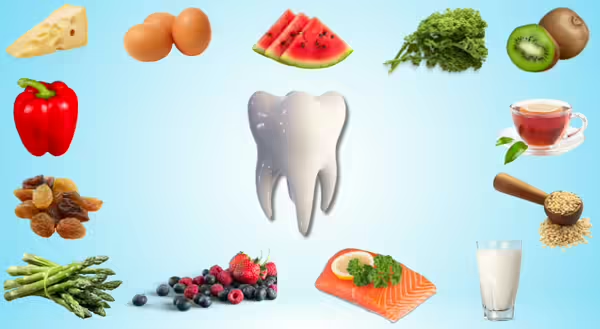
“All that candy will make your teeth fall out” is a common expression typically heard around sugar-filled holidays. The brain needs sugar to function, but too much sugar can cause problems, including cavities and gum disease. The Academy of Nutrition and Dietetics found starchy snacks like cookies and cakes, sticky food like caramel, sugar-sweetened beverages such as carbonated beverages, fruit, and energy drinks, and sweetened tea and coffee increase the risk of dental issues. Interestingly, behaviors such as drinking sugar-sweetened beverages over a long period, eating sticky foods alone, and frequently eating simple sugars like honey, table sugar, and molasses increase the risk of dental problems.
Not all foods are harmful to teeth. Chewing sugar-free gum and mint candies decreases the risk of dental problems. Eating a diet full of the following can protect teeth:
- Whole grains
- High-quality protein like eggs, cheese, fish, and beans
- Plenty of fruits and vegetables
Look for foods high in calcium.
Calcium is a mineral important for bone health and teeth! It can help prevent tooth decay by protecting the outside of teeth and fighting against acids consumed. The National Institute of Health suggests that most adults aim for 1,000 milligrams of calcium, and older adults try to consume up to 1,200 milligrams daily.
Food with calcium
If asked, most people associate calcium with dairy products such as milk. One cup of milk has 300 milligrams of calcium. Calcium is also found in cheese, yogurt, green vegetables like broccoli, arugula, okra, collard greens, kale, and spinach. Dried figs and kiwi fruit are also good sources of calcium.
Other foods that contain calcium are fish such as salmon, sardines, and mackerel, which contain 170 to 370 milligrams of calcium per 3 oz., or about the size of a deck of cards. Calcium can also be found in fortified beverages and food, such as some cereals and orange juice.
Phosphorus is another mineral that can keep teeth strong!
Meat, poultry, fish, eggs, beans, sesame seeds, potatoes, asparagus, and kidney beans are just a few examples of foods high in phosphorus. Just like calcium, dairy products typically also contain phosphorus. Plain yogurt, milk, and salmon contain some of the highest phosphorus per serving. A phosphorus deficiency is rare as most people get enough through what they eat.
Fruits and vegetables also contain vitamin A, vitamin C, and fiber, which help protect teeth, keep teeth clean, and produce saliva to wash away acids.
Don’t forget about fluoride!
When talking about teeth, one nutrient that can’t be forgotten about is fluoride. Fluoride is a mineral-like calcium and phosphorous found in the air, water, and soil. One of the ways fluoride protects teeth is by strengthening the outer layer or enamel of teeth.
So, how do people consume fluoride? One of the main ways is through tap water! Most bottled waters do not contain fluoride, so vary tap versus bottled water consumption or read the labels. Other ways to get fluoride is through toothpaste and mouthwash. Fluoride is absorbed in the stomach and stored in teeth and bones. Some foods do contain fluoride, thanks to the soil found in plants. For example, black tea and coffee naturally contain fluoride. Oatmeal, raisins, and potatoes are also a source of fluoride.
After talking about all these different minerals associated with dental health, here are a few last-minute reminders to protect teeth:
- Try chewing sugarless gum to help produce salvia and remove food stuck in your teeth.
- Dairy can help restore calcium and phosphorous to teeth and keep them strong! Aim to add an extra serving of cheese, milk, or yogurt to a meal this week.
- Drink more water and read the label! Look at your next bottle of water and investigate if it contains fluoride, or search for bottled water that contains fluoride to prevent tooth decay.
Learn more about the amount of calcium, phosphorous, and fluoride in foods through the National Institute of Health.
About the Author: Lisa Peterson is an Illinois Extension Nutrition and Wellness Educator serving Christian, Jersey, Macoupin, and Montgomery counties in west central Illinois. Her interests include using social media marketing and technology to translate research-based information in food safety, optimal nutrition, preparing and safely preserving food, preventing and delaying chronic disease through diet management, and developing innovative methods for implementing wellness in the workplace. She has a passion for translating science-based research for consumers to use locally. She dedicates her work to improving Illinois's citizens' lives by providing them with the tools to make safe, healthy, and informed decisions. You can reach Lisa at lap5981@illinois.edu or at (217) 532-3941